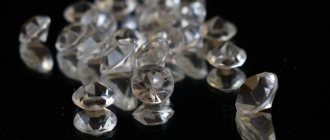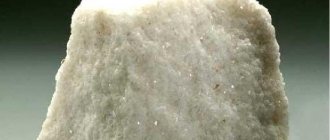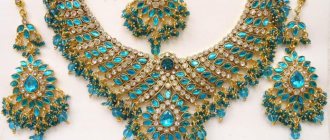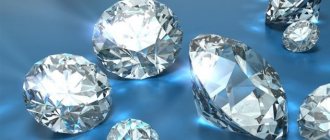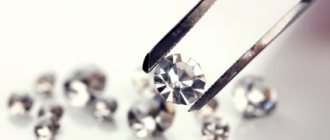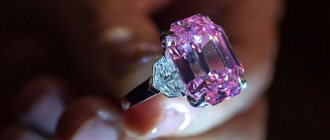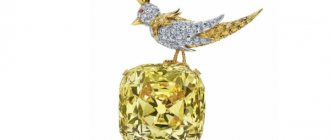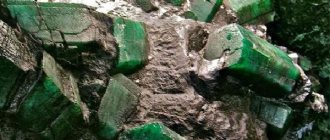Group of organic stones
Geologists, collectors and jewelers evaluate and classify stones in different ways. For jewelers, transparency and brilliance are important; for mineralogy, the chemical composition of the nugget is important. Collectors look at the value of the mineral and its rarity in nature. Thus, in different years, different classifications were used, according to which stones were assigned to one group or another.
In 1896, Max Bauer proposed dividing all gems into three types: precious stones, semi-precious stones, and stones of organic origin. It is the third group that we will talk about in this article.
Organic stones were formed mainly as a result of the petrification of living nature. These include corals, amber, pearls, jet and others. The mesmerizing beauty of these specimens has delighted people for several millennia. They are used to create jewelry; large samples with unique colors or sizes are sold at auctions or placed in the best museums in the world. Thanks to such finds, historians can clearly see what living creatures inhabited our planet in ancient times.
Are stone and mineral the same thing?
Often in everyday life we use the words stone, mineral, gem as synonyms, but in fact, let's figure it out - are these synonyms?
A mineral is a single type of chemical substance that has a crystalline structure. If the composition of chemicals differs slightly, but the structure is similar, then varieties are distinguished based on color or other characteristics. For example, quartz, depending on the characteristics of its composition, has the following types: rock crystal, amethyst, chalcedony, citrine.
Stone is a broader concept. As defined by Wikipedia, it is a mineral or solid rock of natural origin, excluding sand and metals.
Most gemstones are minerals.
Types of organic stones
Why do some types of organic matter become fossilized? What processes occur in this case? There are several types of organic fossils, each of which has its own characteristics during formation, and also differs in external characteristics. Let's look at the most popular formations in this group:
- Ammonites;
- Ivory;
- Nacre;
- Coral;
- Amber;
- Pearl;
- Jet;
- Petrified wood;
- Devil's finger (belemnitis).
The stones listed above are radically different from each other. At first glance, it is even difficult to imagine why they were combined into one group. Some of them were formed from plants, which, due to external factors over several millennia, formed amazing nuggets. Others were formed in a much shorter time by separating organic substances from living mollusks.
Igneous origin
Magma (from the Greek “mash”, “fiery liquid melt”) - has a temperature of about 1500 degrees Celsius. As magma cools, rocks and minerals are formed. If cooling occurs at depth, then they speak of plutonic rocks (from Pluto, the God of the earth’s interior), and if on the surface of the earth’s crust, they speak of volcanic rocks (from Vulcan, the God of fire and blacksmithing).
Lavas and magmas can be different in chemical composition and viscosity, which also affects the creation (crystallization) of minerals and their classification in the future - by time of formation, by depth, by the “acidity” of the magma, etc.
Crystals of various minerals are formed not during the cooling process itself (different minerals would “interfere” with each other), but during the so-called post-magmatic processes. Crystals grow in the voids of rocks and then emeralds, sapphires, topazes, quartz, rubies, alexandrites are formed - typical representatives of the post-magmatic mineralization process.
Emerald Ruby Topaz Sapphire Smoky Quartz Alexandrite
If surface temperatures are low, then not transparent, but “patterned” minerals are formed, such as opal, agate, malachite, for example.
Chalcedony (the photo shows its variety - agate) is formed in near-surface conditions.
The “king” diamond stands apart from everyone else. He may be the same age as Earth. It has special conditions of formation - in the mantle at a depth of more than 100 km at the highest pressure and temperature. It is “delivered” to the surface of the earth by kimberlite pipes.
Sedimentation is another long-term process of formation of rocks and minerals. It is based on external influences of the atmosphere and water. Rocks are transported from the surface by sediments or rivers, and they are weathered and washed away. Amber, jets, coral and pearls are of direct sedimentary origin.
Amber Jet Coral Pearl
Organic formations from shellfish
Ammonites
Hundreds of millions of years ago, during the time of dinosaurs, molluscs called ammonites lived in the ocean. Their amazing shells, curled with a ram's horn, have been preserved to this day. However, geologists sometimes find them far from water. This is due to the fact that in past eras the seas were located in other places. Some samples of whole ammonites are gigantic in size - the largest of them weighs more than 3 tons, its diameter is 1.5 meters. The most valuable are fossilized ammonites with remains of mother-of-pearl on the surface. Jewelers often use these fossils in various types of jewelry. Some types are processed in such a way that the mother of pearl covering the inside of the shell favorably emphasizes the beauty of the nugget. In other specimens, on the contrary, the emphasis is on the beauty of the patterns formed from limescale.
Devil's finger (belemnite)
Belemnite mollusks also lived in the Jurassic and Cretaceous periods. Visually, they are similar to squids, but they had a shell that consisted of the following parts: phragmocone, proostracum and rostrum. The last part was the strongest and looked like a pointed cylinder. It is this part of the shell that has survived to this day and is one of the types of organic fossils. Looking at the shape of the fossil, belemnite got its middle name - devil's finger. The average length of the rostrum is 20 cm, some finds measure 50 cm.
Nacre
An organic formation called mother-of-pearl is also incredibly beautiful and durable. It represents the inside of the shell in which the pearl is formed. That is why the stone received such a name - in German “Perl Mutter” means “mother of pearls”. A distinctive feature of the nugget is its variety of shades and incredible shine. Creating jewelry from mother-of-pearl requires high professionalism of the craftsman. The gem consists of calcium carbonate, water and organic compounds secreted by shellfish.
Pearl
Despite the variety of marine fossils, it is safe to say that pearls are the most valuable and unique. It can form in some types of shells - marine or freshwater. When a foreign body gets inside, the mollusk begins to secrete secretions, with the help of which it protects itself from “uninvited guests.” The coated layers have a delightful pearlescent sheen. Different types of pearl oysters have different secretions that differ in color. Thus, the most expensive is considered to be black pearls, which are created by oysters of the species Pinctada margaritifera; they live in the Hawaiian Islands - Figure 1.
Given the enormous popularity of pearls, experts have created entire farms that grow organic stone. They independently implant small grains of sand into the shell, after which the work of the mollusk begins. It takes about 10 years to create an average-sized pearl.
Let's sum it up
Thus, all stones (and not only precious ones, since the classification of stones and minerals is still being improved) can be of mineral or organic origin.
Mineral origin refers to three types of processes that resulted in the formation of rocks and minerals:
- igneous;
- sedimentary and
- metamorphic.
Of organic origin are: ammolite, buranite, jet, pearl, coral, petrified wood, mother-of-pearl, devil's finger and amber.
Fossils of living organisms
Coral
The warm waters of the world's oceans are home to huge coral reefs and entire islands. They consist of polyps - living marine invertebrate organisms. Their varied colors and unusual shapes have captivated millions of people. Corals are composed of calcium carbonate with the addition of various impurities. Collectors prefer to have complete skeletons of marine fossils. Jewelers use them to form magnificent ornamental stones, which they use to create jewelry.
Coral fossils have also been found in the Devonian system of Siberia, rocks formed more than 350 million years ago. Their shapes and colors are not as vibrant as organisms living in the modern period, but these findings are important for scientists.
Ivory
The remains of mammoths, elephants, hippopotamus teeth or walrus tusks can be found in the habitats of these animals. Their surface has a characteristic white-yellow color and a wavy pattern. Large finds are used as material for integral crafts of various interior items, smaller ones are split and small stones or beads are created for the further production of jewelry. Chinese craftsmen have learned to create incredible works of art from ivory.
Metamorphic rock formation
Metamorphosis means complete change or transformation (from the ancient Greek "transformation").
Rocks of igneous and sedimentary origin, depending on physical and chemical conditions, such as temperature, pressure, gases, the chemical influence of magma and catalytic substances, completely change.
Scientists distinguish the following types of metamorphism: immersion (increased pressure and circulation of aqueous solutions); heating; hydration (rocks interact with aqueous solutions); dislocation metamorphism (tectonic shifts); impact (meteorite falls, explosions).
Examples of stones of metamorphic origin: garnets, marble, quartzites, feldspar.
Garnet Marble Rose Quartz Feldspar
Organic fossils from ancient plants
Plants appeared on earth much earlier than all other living organisms. Most of the first trees are long gone from the modern world. This is due to multiple climate changes, which created the necessary conditions for the creation of organic formations from plant remains.
Amber
Amber is a resin extracted from coniferous trees. In the Cretaceous period, such forests were common in the area of the modern Baltic Sea. Humid air and very high temperatures did their job - resin literally oozed from the trees, which, under the influence of changing weather conditions, solidified, and over the next millions of years turned into a fossil. Some specimens are unique in that inside such a stone you can find an insect or a twig of an ancient plant. Such unique samples help scientists obtain news from the distant past - Figure 3.
Jet
Jet is a type of coal formed from the wood of coniferous trees. This change in material is associated with the immersion of wood in sea mud. After this, numerous changes in temperature and pressure contributed to the abolition of the rotting stage. After some time, the substance exposed to air turned into a fossil. All these processes occurred very slowly; it takes millions of years to form jet. Today, the main deposits of the nugget are Russia, Germany, England, France and the USA.
To main§ 11. Organic stones
Stones, the formation of which is associated with the vital activity of the body, are called organic. The characteristic properties of these stones are: low hardness, chemical instability, and sometimes the ability to burn. Organic stones that have jewelry value include: pearls, amber, coral, jet. Pearl.
Old Russian pronunciation is “zenchug”.
It is believed that the name comes from the Chinese “zhen-zhu”. Pearls are solid formations of calcium carbonate. Pearls contain 86 - 90% calcium carbonate, 12 - 6% organic matter, and the rest is water. The shape of the pearl depends on the shape of the foreign body trapped in the mollusk, which is capable of forming protective nacreous deposits. There are more than 30 species of such mollusks. Formations of regular shapes close to a ball are considered the most valuable. The size of the pearls reaches 15 mm. Large specimens are rare. The London Museum houses a pearl measuring 45 mm and weighing 85 g. The color of the pearls is mainly white, with a yellowish or bluish tint, less often yellow, gray, pink, reddish, brownish, blue and black. Pearls are opaque, but shine through to some depth, which is what causes the soft play of light with a pearlescent tint, and is fragile. Its density is 2.65 - 2.75; Mohs hardness 2.5 - 3.5. Chemically unstable. As a result of dehydration and decomposition, organic matter becomes dull and destroyed. Under the influence of dampness it may lose its shine. Act on pearls and fats. It dissolves instantly in hydrochloric and acetic acids. The life of a pearl, depending on conditions, lasts an average of 150 years. Pearls are used very widely in jewelry - without frames and in frames made of precious metals, usually in combination with diamonds. Amber.
Amber (from the Lithuanian “gintaras”) is a fossilized resin-like substance of an amorphous structure.
It can contain a variety of inclusions: grains of sand, pieces of wood, tree leaves, flower petals, various insects that were once caught in the resin of coniferous trees and perfectly preserved in amber. The color of amber ranges from pale yellow in various tones to dark yellow-brown. Amber in red and black colors is very rare. Amber is transparent, but there are pieces with smoky (cloudy) inclusions, which make it translucent or opaque in the places of inclusions. Very often, samples have internal cracks, delaminations, and bubbles. Amber is tough, polishes well, and easily chips when struck or pressed. Has a strong resinous sheen. Amber density 1.1; Mohs hardness 2 - 3. Chemically unstable, easily soluble in benzene and carbon disulfide. At 150°C it softens, at 300°C it melts. It burns with a white, smoky flame, emitting a pleasant smell. In jewelry, amber is used in combination with silver, gold, base metals and without metals. Used for artistic crafts. Coral.
This is a tree-like formation (marine polyp), consisting of lime carbonate, iron oxide and organic matter.
The color of corals is different - white, pink, red; black is found. The most valuable are pink corals. Coral is opaque, with a waxy sheen, less fragile than amber and pearls. Its density is 2.5; Mohs hardness 3 - 4. When exposed to air over time, it can become cracked and, as a result, lose its shine and turn gray. It can be restored by removing the top layer. It dissolves in acids and cannot withstand high temperatures. Corals are used to make gems, various artistic crafts and jewelry in and without metal. Jet.
Jet (black ambergris, tar coal) is a type of black coal. Opaque, with a dull resinous sheen, easy to work and polish. Under a microscope, the woody structure is visible. Density 1.35; Mohs hardness 3.5. It ignites from the fire and burns with a bright, smoky flame. Jet is used as a beautiful material for artistic crafts.
For more information about the properties of jewelry stones, see APPENDIX,
previous page
| table of contents | Next page |
